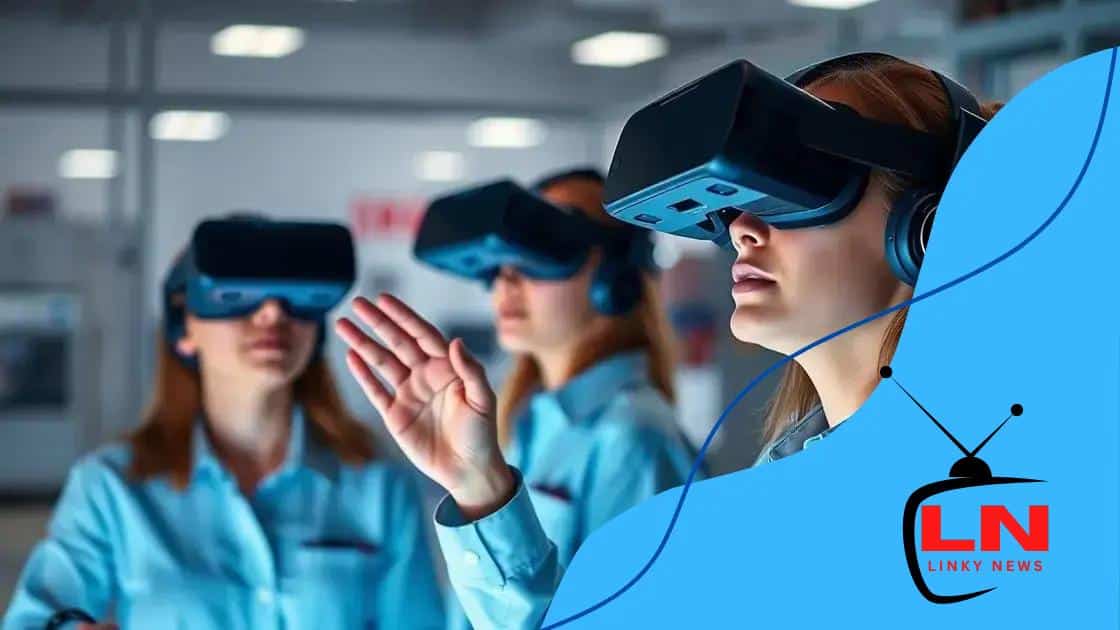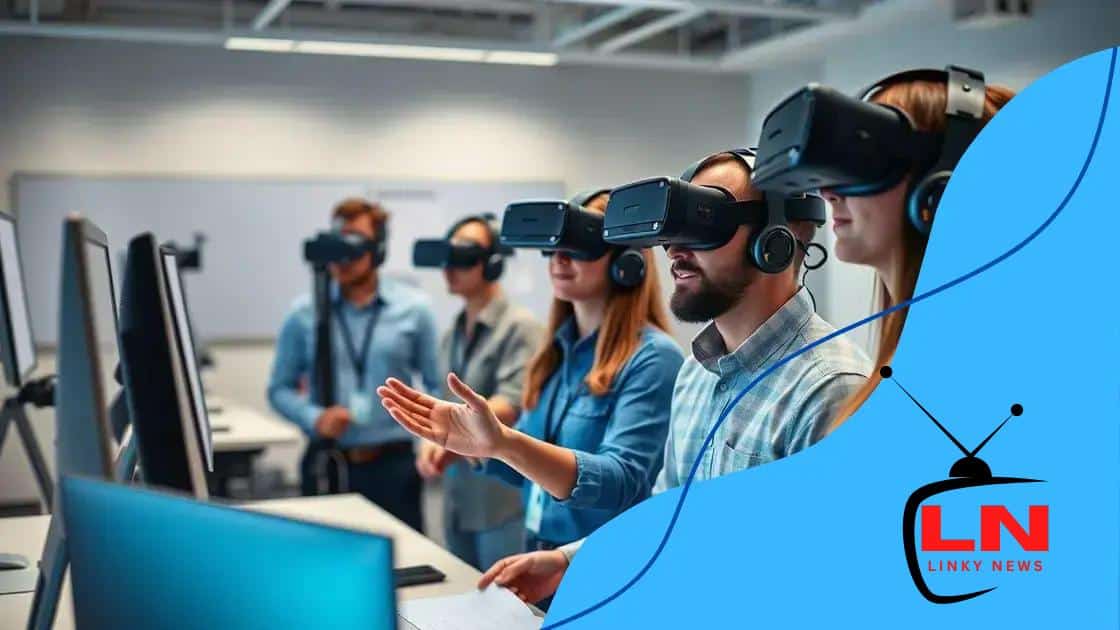Virtual reality for employee training: revolutionizing skills

Virtual reality for employee training enhances engagement, provides a safe learning environment, and allows for tailored skills development, making it an essential tool for modern workforce training.
Virtual reality for employee training is changing the landscape of skill development. Imagine immersing yourself in realistic scenarios that enhance learning and retention!
Understanding virtual reality in training
Understanding virtual reality in training is crucial for organizations looking to enhance their employee’s skills effectively. With VR, trainees engage in immersive experiences that replicate real-world scenarios.
What is Virtual Reality?
Virtual reality is a technology that creates a simulated environment through computer-generated graphics. It allows users to interact within these environments using specialized equipment like headsets and controllers.
How Does VR Training Work?
The basic principle of VR training is to create a lifelike experience that promotes active learning. In this setting, employees can practice skills in a risk-free environment. This method not only boosts confidence but also enhances retention of the material.
Participating in VR training can also lead to better teamwork and communication. As employees navigate challenges together, they learn how to cooperate and solve problems collectively.
Benefits of VR Training
- Increased engagement among employees.
- Safe learning environment for high-risk situations.
- Immediate feedback and assessment.
- Allows for realistic practice without real-world consequences.
Moreover, VR reduces the need for extensive physical materials and spaces for training. Organizations can save money and resources while providing high-quality education. Another benefit is the ability to tailor training programs to individual needs, making learning more effective.
As this technology continues to evolve, the applications of VR in training extend beyond traditional fields. For example, healthcare professionals use VR simulations for delicate procedures, enhancing their skills effectively.
In summary, understanding virtual reality in training offers organizations powerful tools to engage employees and enhance skill development. As more sectors adopt this innovation, its effectiveness in workplace training will only increase.
Benefits of virtual reality for employees
The benefits of virtual reality for employees are transformative. As companies seek to enhance training, VR emerges as a powerful tool that improves learning outcomes.
Enhanced Engagement
Using virtual reality captivates trainees like never before. Immersive experiences grab attention, making learning fun and interactive. This leads to higher retention rates compared to traditional training methods.
Safe Learning Environment
In high-risk jobs, VR provides a critical advantage. Employees can practice in simulations without real-world consequences. This makes it possible to learn from mistakes and develop skills safely.
- Simulating dangerous scenarios without risk.
- Immediate feedback helps improve performance.
- Increases comfort in handling real-life situations.
Furthermore, VR allows for tailored training experiences that meet individual needs. Employees can progress at their own pace, ensuring they fully grasp the material before moving on.
Another significant advantage is cost-effectiveness. Companies can reduce training expenses by minimizing physical resources needed for training rooms and materials. This efficiency allows investment in technology that enhances learning.
Improved Collaboration
VR also fosters teamwork. Employees can work together in virtual environments, enhancing communication and problem-solving skills. Experiencing challenges as a group builds rapport and strengthens professional ties.
As the technology evolves, the applications of VR training continue to expand. More organizations are recognizing the need for innovative training solutions, making virtual reality essential for modern employee development.
How to implement virtual reality training

Implementing virtual reality training requires careful planning and execution. Organizations need to assess their training goals and identify how VR can help meet these objectives.
Step 1: Establish Training Goals
The first step in the implementation process is to define clear training goals. Determine what skills or knowledge you want employees to gain. This could include improving safety skills, enhancing customer service interactions, or developing teamwork abilities.
Step 2: Choose the Right Technology
Selecting the appropriate VR technology is crucial. Today, numerous platforms and hardware options exist. Consider aspects like user-friendliness, compatibility, and content quality.
- Evaluate different VR headsets available in the market.
- Choose software that aligns with your training needs.
- Ensure the technology is scalable for future training requirements.
A successful setup will also require the right space for training. Ensure you have an area where employees can move freely and interact with the virtual environment comfortably.
Step 3: Develop Training Content
Developing relevant training content is key to engaging employees. Collaborate with subject matter experts to create realistic scenarios that replicate real life as closely as possible. This increases the effectiveness of the training.
Keep in mind to integrate assessments that allow trainers to measure employee progress. Regular feedback helps employees improve and adjust as needed.
Step 4: Train the Trainers
Trainers need to be proficient in using the VR technology and facilitating the training sessions. Provide them with adequate training on how to operate the equipment and guide employees through the virtual sessions.
Frequent evaluations and adjustments to the training program are necessary to ensure it meets employee needs. Encourage open communication and gather feedback from users to continuously improve the experience.
Finally, celebrate milestones and successes. Acknowledging achievements motivates employees to engage further with their training.
Case studies of VR in employee training
Case studies of VR in employee training show compelling evidence of its effectiveness. Organizations across various industries are adopting VR to enhance their training programs.
Healthcare Sector
In the healthcare sector, VR has transformed how surgeons train. For instance, a hospital implemented a VR program that allows surgical residents to practice complex procedures in a safe environment.
- Residents can rehearse surgeries multiple times.
- They receive instant feedback to improve techniques.
- Risky scenarios can be simulated for better preparedness.
This approach not only improves the skills of medical professionals but also increases patient safety by reducing errors in actual surgeries.
Retail Training
In retail, a major company introduced VR training to onboard employees efficiently. New hires participate in virtual simulations that replicate real-life customer interactions and store scenarios.
As employees navigate through challenges, they learn how to handle difficult situations, improve customer service skills, and become familiar with store layouts.
Corporate Leadership Development
Another notable case study comes from a Fortune 500 company that uses VR for leadership training. Leaders engage in virtual scenarios that test their decision-making skills and crisis management.
- They practice negotiations and conflict resolution.
- Real-time assessments help track their progress.
- They receive coaching based on their performance.
Such immersive training allows leaders to develop skills in a controlled, yet realistic setting.
These case studies illustrate how virtual reality can revolutionize employee training across industries. Companies are witnessing improved engagement, enhanced skill retention, and better training efficiencies. As VR technology continues to evolve, more organizations will likely adopt it to prepare their employees for real-world challenges.
The future of training with virtual reality
The future of training with virtual reality looks bright and full of possibilities. As technology advances, more industries are discovering the benefits of VR for workforce development.
Expanding Applications
VR is set to expand its applications beyond traditional sectors. Healthcare, education, and corporate settings are just the beginning. Future developments may include fields like engineering, where complex concepts can be visualized in three-dimensional space.
Increased Accessibility
As VR technology becomes more affordable, smaller companies can also benefit. This increased accessibility allows more employees to receive high-quality training experiences. With mobile VR options, employees can train from anywhere, making learning flexible and convenient.
- Remote training sessions enable continuous learning.
- Smaller businesses can adopt VR without heavy investment.
- More diverse training content will be available for different industries.
The cost-effectiveness of VR will lead to widespread adoption, allowing companies to train more employees simultaneously without needing physical space.
Integration with AI and Analytics
Another exciting trend is the integration of artificial intelligence with VR training. Using AI, VR systems can personalize training sessions based on individual performance. This allows employees to receive tailored feedback and adapt their learning paths.
Additionally, analytics tools will track progress and engagement levels. Organizations can use this data to refine their training programs continuously and ensure they meet employee needs.
As we look ahead, the collaboration between virtual reality and other technologies will create powerful training solutions. These tools will enable employees to build skills and address challenges effectively, paving the way for a smarter workforce.
FAQ – Frequently Asked Questions about Virtual Reality Training
What are the main benefits of using virtual reality for employee training?
Virtual reality increases engagement, provides a safe learning environment, reduces training costs, and allows for tailored learning experiences.
How can companies implement virtual reality training?
Companies can implement VR training by establishing clear goals, selecting the right technology, developing engaging content, and training their trainers.
What industries are using virtual reality for training?
Industries such as healthcare, retail, and corporate training are adopting VR to enhance skill development and improve employee performance.
Is virtual reality training suitable for all employees?
Yes, VR training can be customized to fit various skill levels and roles, making it suitable for all employees.





